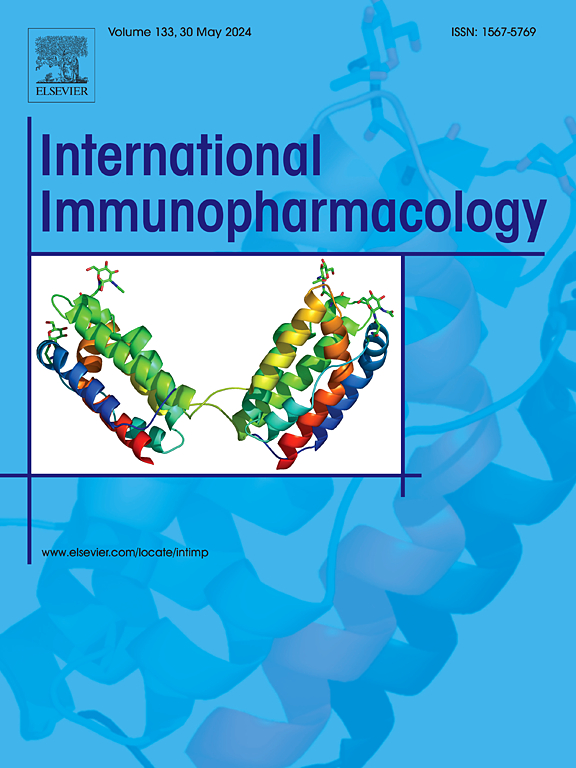Muscone通过Nrf2/system Xc-/GPX4信号通路调节心肌细胞铁下垂,从而减轻心肌梗死。
IF 4.7
2区 医学
Q2 IMMUNOLOGY
引用次数: 0
摘要
急性心肌梗死(Acute myocardial infarction, MI)是世界范围内发病率最高、严重威胁公众健康的疾病之一,目前临床治疗方法存在较大风险。铁上沉是一种程序性细胞死亡,具有铁依赖性和细胞内氧化积累的特点,为心肌梗死的治疗开辟了新的途径。麝香体是麝香的主要活性单体之一,可改善心肌梗死和心肌缺血再灌注损伤后的心室重构。然而,肌细胞介导的心肌梗死治疗的铁下垂机制尚不清楚。因此,本研究旨在探讨muscone在体内和体外心肌梗死治疗中的作用机制。值得注意的是,在体内模型中,muscone可以减轻心肌梗死损伤,增加心肌血管生成,抑制心肌铁下垂。此外,在大鼠心肌细胞H9c2细胞的体外实验结果表明,muscone可以抑制缺氧诱导的细胞损伤,提高细胞活力,抑制细胞凋亡和铁凋亡。在机制上,muscone介导的铁凋亡抑制是通过核因子红系2相关因子2 (Nrf2)/System Xc-/谷胱甘肽过氧化物酶4 (GPX4)信号通路调节来治疗心肌梗死的。综上所述,本研究结果显示muscone在心肌梗死治疗中的治疗潜力。这些发现为开发针对Nrf2/System Xc- /GPX4信号通路的治疗方法提供了重要的见解。本文章由计算机程序翻译,如有差异,请以英文原文为准。
Muscone attenuates myocardial infarction by regulating ferroptosis of cardiomyocytes through Nrf2/system Xc-/GPX4 signaling pathway
Acute myocardial infarction (MI) is among the diseases with the highest incidences and seriously threatens public health worldwide, with the present clinical treatment methods presenting considerable risks. Ferroptosis, characterized by iron dependence and intracellular oxidative accumulation, is a type of programmed cell death that has opened new avenues for treating MI. Muscone is one of the major active monomers of musk, which can improve ventricular remodeling after MI and myocardial ischemia-reperfusion injury. However, the ferroptosis mechanism underlying muscone-mediated MI treatment remains unelucidated. Therefore, this study aimed to investigate the mechanisms of action of muscone in MI management both in vivo and in vitro. Notably, muscone could attenuate MI injury, increase myocardial angiogenesis, and inhibit myocardial ferroptosis in the in vivo rat model. Furthermore, in vitro experiment results in rat cardiomyocytes H9c2 cells showed that muscone could inhibit hypoxia-induced cell damage, improve cell viability, and inhibit cell apoptosis and ferroptosis. Mechanistically, muscone-mediated ferroptosis inhibition was regulated by the nuclear factor erythroid 2-related factor 2 (Nrf2)/System Xc−/glutathione peroxidase 4 (GPX4) signaling pathway to treat MI. Altogether, the results of this study show the therapeutic potential of muscone in MI treatment. These findings provide notable insights regarding the development of therapeutic approaches targeted at the Nrf2/System Xc- /GPX4 signaling pathway.
求助全文
通过发布文献求助,成功后即可免费获取论文全文。
去求助
来源期刊
CiteScore
8.40
自引率
3.60%
发文量
935
审稿时长
53 days
期刊介绍:
International Immunopharmacology is the primary vehicle for the publication of original research papers pertinent to the overlapping areas of immunology, pharmacology, cytokine biology, immunotherapy, immunopathology and immunotoxicology. Review articles that encompass these subjects are also welcome.
The subject material appropriate for submission includes:
• Clinical studies employing immunotherapy of any type including the use of: bacterial and chemical agents; thymic hormones, interferon, lymphokines, etc., in transplantation and diseases such as cancer, immunodeficiency, chronic infection and allergic, inflammatory or autoimmune disorders.
• Studies on the mechanisms of action of these agents for specific parameters of immune competence as well as the overall clinical state.
• Pre-clinical animal studies and in vitro studies on mechanisms of action with immunopotentiators, immunomodulators, immunoadjuvants and other pharmacological agents active on cells participating in immune or allergic responses.
• Pharmacological compounds, microbial products and toxicological agents that affect the lymphoid system, and their mechanisms of action.
• Agents that activate genes or modify transcription and translation within the immune response.
• Substances activated, generated, or released through immunologic or related pathways that are pharmacologically active.
• Production, function and regulation of cytokines and their receptors.
• Classical pharmacological studies on the effects of chemokines and bioactive factors released during immunological reactions.

 求助内容:
求助内容: 应助结果提醒方式:
应助结果提醒方式:


